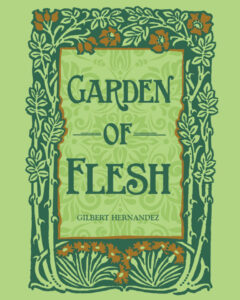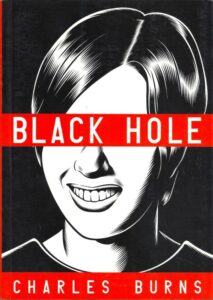This week I’ve read three graphic novels. Or maybe they’re collected editions. Whichever they are two of them were old and one was new. At least it was new to me. It came out five years ago in 2016.
The first is “Black Hole” by Charles Burns. This was originally published in single issue form over a nine year period from 1996-2004 (350 pages). It’s a book I always meant to check out back then but somehow never did. It’s an indie book published by Fantagraphics and I’m an indie comic reader who has bought a lot of books published by them over the years. I’m not sure why this one slipped by me.
I bought the hardcover collected edition back in 2006 and that’s the one I still have. I only remember that I read it back then and was disappointed by it. But I also remember thinking that it may have been me and not the book. Sometimes I read things and they hit me wrong but it’s me and my mood and not the book. I usually know when this happens (it’s actually rare) and give it some time until I reread the book. Somehow fifteen years slipped by with me thinking, “I really should reread “Black Hole.” So I finally did.
“Black Hole” is considered a classic by many comic book fans and I can see why. The art is clean lined, well drawn, and precise. It’s a tour de force of lush ink work. There is a prettiness to the horror of the art. Yes, this is a horror comic.
“Black Hole” is a story that takes place in a world where a STD gives you horrifying disfigurements. The lucky few only get small disfigurements. It stars teenagers and their lives as they live with and without the disease. If you catch it you’re generally cast out of society. But the story doesn’t involve the ones doing the casting out very much. It’s almost all about the cast out teens.
The horror has not only to do with being turned into a monster but also with being cut adrift from friends and family. None of these kids have a strong support system and they easily cut themselves off from their families and live in the woods. They still have the hopes and dreams of teenagers though and have to cope with those.
“Black Hole” is certainly not your average horror comic. It has some sad and horrific moments, especially in the third act, but a lot of the scariness come from these teens having their world change in an instant and not being able to cope with it. It’s a very emotional book filled with dreams and nightmares. Good stuff.
The second book I read this week is the one that was new to me. “Garden of the Flesh” by Gilbert Hernandez. It’s a small book at only 4.5×6 inches. It has 96 pages with only two panels on a page. I didn’t even know this book existed until this week. I read it described as blurring the line between erotica and porn. I like Gilbert and I like blurred lines so I was in.

The book is about Adam and Eve. It tells theire story plus the story of their two sons Cain and Abel and it throws Noah in for good measure. And everybody is having sex. First we get Adam and Eve having sex then Eve and the Devil. After Cain murders Abel he goes off to find a wife to have sex with. Finally we get Noah out finding a wife to have sex with and then it flashes forward to his children and their spouses having sex as the arc is being built.
I enjoyed the book and there were plenty of drawings of people having sex but I found it to be neither erotica nor porn. Having just read (a few weeks ago) the erotic comic “Birdland” that Gilbert made in the early 1990s this one seemed less concerned with being erotic. It was more matter of fact. It was more like “Here are the chaste stories you’ve heard all your life with sex, that they all obviously had to be having, thrown in.” I liked it.
The third book I’ve been reading this week is the collected “Puma Blues.” It runs 545 pages and I bought the original issues of this series when it was coming out back in the mid 1980s. They came out with this collected hardcover back in 2015 and it’s been on my wishlist ever since then. I finally decided to buy it this week as the price dropped down to $20.

A note on the binding of this book. It was terrible in that the spine was glued solid. The book would barely open. It looked to me like it had a sewn binding so the book should open and the sewn part should bend off the spine itself. It didn’t. So I took a hacksaw blade and worked it between the spine and the sewn binding until I released all the glue. Now I can open the book and everything seems fine. I’ve never had to do that to a book before.
“Puma Blues” itself is about nuclear and environmental anxiety. It was made from 1985-1989 but takes place in the near future of the year 2000. Though there are many characters the main one is a man who is working at an isolated lake measuring the ph balance of the lake as the government works to counteract the effects of acid rain. He spends a lot of his time watching old videos his deceased father made and contemplating what he believes in and what he should do with his life. He is also ex-military and I think he suffers from PTS.
A lot of this book is about wildlife and the environment. There is more wildlife drawing in this book than in any other I know of. Sometimes you get pages in a row of the animals living near the lake. It’s a type of visual storytelling only found here. It’s really nice.
There are other characters and events going on in the story and they all seem to illustrate the general anxiety of our lead. Everybody is trying to deal with how life is in the year 2000. It’s not post apocalyptic in any way but there are challenges.
It’s written by Steven Murphy and drawn by Michael Zulli. The writing style is interesting in that sometimes it comes to the front with a lot of words but often it moves to the back as the drawings take center stage. Zulli’s black and white art is filled with lots of lines that are kind of disordered in the beginning but by the middle come together with some of the most detailed drawings of animals I’ve ever seen in a comic book.
“Puma Blues” is also interesting in that sometimes the words and pictures tell a parallel story. They words are telling you one thing while the pictures show you another. Then they join up in the literal again. The story moves smoothly from the symbolic to the real very well.
“Puma Blues” was a favorite of mine back in the 1980s and I think I last read my single issues about ten years ago. It’s still a favorite and I’m enjoying reading it in this new form. I miss the color covers though. They’re not in the book.
